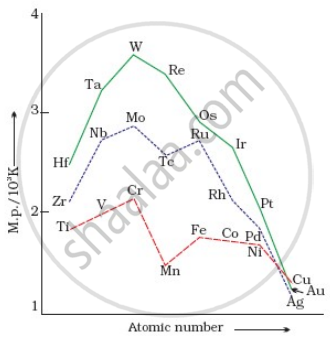Advertisements
Advertisements
प्रश्न
How would you account for the following : Transition metals form coloured compounds
Explain The transition metals generally form coloured compounds.
उत्तर १
In the presence of ligands, the d-orbitals of transition metal ions split up into two sets of orbitals having different energies. Thus, the transition of electrons takes place from one set to another. The energy required for these transitions is quite less and falls in the visible region of radiation. The ions of transition metals absorb the radiation of a particular wavelength and the rest is reflected, imparting colour to the solution.
उत्तर २
Most of the complexes of transition metals are coloured. This is because of the absorption of radiation from visible light region to promote an electron from one of the d−orbitals to another. In the presence of ligands, the d-orbitals split up into two sets of orbitals having different energies. Therefore, the transition of electrons can take place from one set toanother. The energy required for these transitions is quite small and falls in the visible region of radiation. The ions of transition metals absorb the radiation of a particular wavelength and the rest is reflected, imparting colour to the solution
APPEARS IN
संबंधित प्रश्न
Calculate magnetic moment of `Fe_((aq))^(2+) ion (Z=26).`
How would you account for the following:
Of the d4 species, Cr2+ is strongly reducing while manganese (III) is strongly oxidising.
What is meant by 'disproportionation'? Give two examples of disproportionation reaction in aqueous solution.
Which metal in the first series of transition metals exhibits +1 oxidation state most frequently and why?
NF3 is possible, but NF5 is not. Why?
How would you account for the following?
Transition metals and their compounds act as catalysts.
Give reasons for the following:
The transition metals generally form coloured compounds.
Transition metals with highest melting point is ____________.
Which of the following statements is not correct?
Out of \[\ce{Cu2Cl2}\] and \[\ce{CuCl2}\], which is more stable and why?
Match the properties given in Column I with the metals given in Column II.
| Column I (Property) | Column II (Metal) | |
| (i) | Element with highest second ionisation enthalpy |
(a) \[\ce{Co}\] |
| (ii) | Element with highest third ionisation enthalpy |
(b) \[\ce{Cr}\] |
| (iii) | \[\ce{M}\] in \[\ce{M(CO)6}\] is | (c) \[\ce{Cu}\] |
| (iv) | Element with highest heat of atomisation |
(d) \[\ce{Zn}\] |
| (e) \[\ce{Ni}\] |
Assertion: Separation of \[\ce{Zr}\] and \[\ce{Hf}\] is difficult.
Reason: Because \[\ce{Zr}\] and \[\ce{Hf}\] lie in the same group of the periodic table.
Answer the following question:
Which element of the first transition series has highest third ionisation enthalpy?
It has been observed that first ionization energy of 5 d series of transition elements are higher than that of 3d and 4d series, explain why?
On the basis of the figure given below, answer the following questions:

- Why Manganese has lower melting point than Chromium?
- Why do transition metals of 3d series have lower melting points as compared to 4d series?
- In the third transition series, identify and name the metal with the highest melting point.
On strong heating AgNO3, the gases evolved are:-
Which does not belong to first transition series?
Passing H2S gas into a mixture of Mn2+ and Ni2+, Cu2+, ions in an acidified aqueous solution precipitates.
How is the variability in oxidation states of transition metals different from that of p-block elements?
Decide which of the following atomic numbers are the atomic numbers of the inner transition elements:
29, 59, 74, 95, 102, 104
